Heavy Machining in Wisconsin
Heavy Machining in Wisconsin
A machine shop performs a variety of fabrication activities, including cutting, milling, turning, welding, and fabrication. Machine shops require specialized tools and equipment, which they use to create parts from a wide range of metal materials.
Each machining process requires different tools and skill sets, so skilled machinists undergo specialized training and certifications to operate the equipment within a machine shop. In addition, they must have a thorough understanding of their customer’s operation, in order to ensure that the final product or component will suit the needs of the intended application. In addition, computer numerical control (CNC) technology has automated many machining processes to provide superior accuracy and control during production.
Trade Tech, Inc. is committed to ensuring that our customers in every industry receive superior-quality machined parts. As a leading provider of machining in Wisconsin, we provide speedy, cost-efficient, and accurate machining services for everything from aircraft and automotive parts to construction and agricultural equipment. Our state-of-the-art facility is ISO 9001:2008 compliant, with an extensive fleet of CNC turning, milling, welding, sawing, and cutting equipment available.
Trade Tech: Your Full-Service Machine Shop
For more than 35 years, Trade Tech, Inc. has been Hartford, Wisconsin’s premier family-owned and operated manufacturing company. Our full-service machine shop uses the latest in precision CNC machining, large machining, and fabrication services to customers in Wisconsin and across the United States.
We pride ourselves on our advanced machining capabilities. Our portfolio of premium manufacturing services includes:
CNC Machining
CNC machining uses advanced software to guide cutting and milling tools. Machining is a subtractive manufacturing method, which means material is removed from a metal or plastic base material or substrate to shape a piece of stock material in accordance with instructions derived from a digital design file. These computer-controlled systems can produce even highly complex and large components within extremely tight tolerances with a high rate of repeatability. 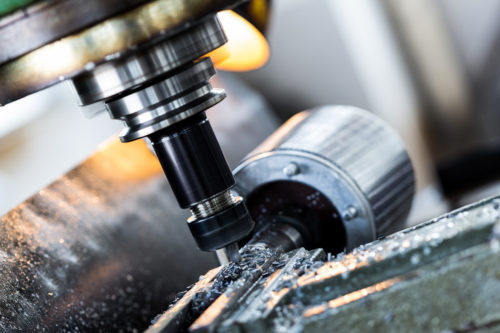
Trade Tech is proud to offer top-quality CNC machining in Wisconsin. For more than 30 years, we have been the go-to supplier for customers with oversized and complex components that have demanding tolerance requirements. Our comprehensive fleet of modern machining equipment includes:
- Horizontal mills
- Vertical mills
- Boring bars
- Multi-axis machining centers
- CNC and manual lathes
Metal Fabrication
Trade Tech’s metal fabrication services encompass a wide range of processes, including welding, sawing and waterjet cutting. Whether you are in need of detailed waterjet cutting or large-scale welding, we have the knowledge and experience necessary to provide you with quality components quickly and efficiently. With an extensive range of metal fabrication equipment, we can produce parts that meet highly detailed specifications. Our metal fabrication services include the following:
- Welding and weldments
- Horizontal and vertical sawing
- Five-axis abrasive waterjet cutting
Certified Welding
Our expert staff of certified welders excel at creating reliable joints using the latest in welding technology. We pride ourselves on our ability to produce welded parts consistent with the most stringent industry standards, including nuclear safety-related welding. In addition, our welders maintain code certifications for AWS D1.1 (steel), AWS D1.6 (stainless steel), and AWS D14.1 (industrial mill and crane welding). Our capabilities feature both arc and resistance welding 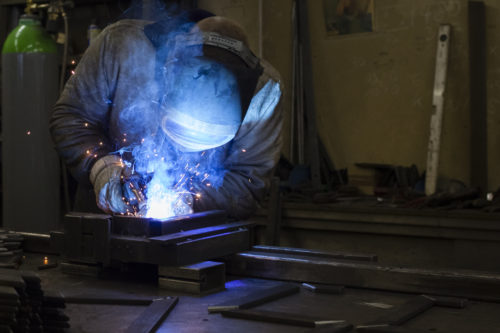 processes, including:
processes, including:
- MIG Welding/Gas Metal Arc Welding (GMAW)
- TIG Welding/Gas Tungsten Arc Welding (GTAW)
- Flux Core Arc Welding (FCAW)
We provide manual and semi-automatic welding, with special expertise in the welding of structural plates, stainless steel, and ferrous metals. With 50 foot long, 100,000 pound T-slot tables, large format fixtures, and state-of-the-art positioning equipment with 30,000 lbs capacity, our ability to produce precision components within tight tolerances is second-to-none.
Project Management
Our cutting-edge manufacturing technology is supported by our dedicated team of project management professionals. Due to our expertise and extensive capabilities, Trade Tech has become a manufacturer of choice for numerous unique and unconventional projects. To ensure that our clients have everything they need throughout the design, manufacturing, and production processes, we also offer end-to-end project management services.
By incorporating value-added services utilizing our trusted third party vendors for bending, grinding, rolling, plating, heat treatment, and quality assurance testing, we ensure every project we manage operates with the utmost efficiency and cost-effectiveness, with quick and reliable turnarounds.
Our experienced team has provided premium project management services for customers in sectors such as engineering, mining, manufacturing, construction, oil and gas, and renewable energy.
Industry Focus
Trade Tech, Inc. has extensive experience providing precision machining services for our customers in a broad range of industries, including:
- Aerospace
- Construction
- Defense/Military
- Engineering
- Expander Tools
- Forestry
- Forging Plants
- Industrial
- Marine Industrial
- Mining
- Mold and Die-Cast
- Nuclear Power
- Oil and Gas
- Rock Crushing
- Spin Tools
- Tanneries
- Wind Energy
Trade Tech: Large Machining and Fabrication
As a leading provider of advanced machining services, we understand that every business has different needs. We tailor our methods to meet the needs of your project while ensuring consistent quality throughout. All of our manufacturing processes are highly documented to ensure consistency and traceability, and we verify everything we manufacture through a series of rigorous quality checks and inspections.
Our seasoned experts will discuss your project specifications in detail to ensure we understand exactly what you need. Our hallmark is proficiency and reliability, and our customers know that they can depend on our knowledge, skill, and experience to produce exceptional products with a high degree of consistency.
To see how our heavy machining and other fabrication services can support your project, please contact us today.
Overview of Resistance Welding Processes
Resistance welding is a welding technique in which pressure and an electric current are applied to two pieces of metal, causing the metal to melt and form a weld. The resistance welding process requires no other materials, making it a highly cost-effective method of joining metals. There are many different types of resistance welding techniques, each of which has a different welding application suitable for particular situations.
FCAW (Flux Core Arc Welding)
The flux core arc welding (FCAW) process utilizes heat from an electrical arc to fuse base metals. The arc forms between the workpiece and the continuously fed wire electrode, both of which melt together to form a weld joint. This process is similar to MAG welding except instead of a solid metal electrode, the electrode is hollow, tubular, and filled with flux. 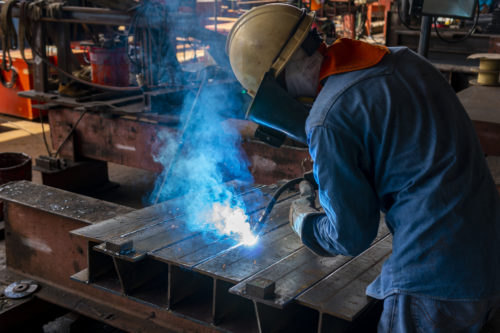
FCAW can be done in two different ways: one that utilizes a shielding gas and one that relies on the flux core alone. With the shielding gas method, shielding gas is provided by a high-pressure gas cylinder to protect the weld pool from oxidation. Common shielding gases include carbon dioxide or a combination of carbon dioxide and argon. This method is preferred when welding thicker metals and delivers welds with consistent mechanical properties and fewer defects.
When performed without shielding gas, FCAW relies on the flux cored electrode to provide gaseous protection. The electrode also produces a slag that covers and protects the molten metal within the weld. This method is extremely portable and can be performed outdoors since there is no need for external shielding gas.
GMAW (Gas Metal Arc Welding)
Gas metal arc welding (GMAW) can be divided into two types: metal inert gas (MIG) and metal active gas (MAG). Each type uses heat from a DC electric arc between the workpiece and a consumable metal electrode, which both melt together to form a weld pool and create the weld joint.
In GMAW processes, the wire electrode is fed from the contact tip of a wire feeding spool gun, and shielding gas is fed through the welding torch to protect the weld from oxidation. With MIG and MAG welding, a compatible filler material must be used. For example, an aluminum wire needs to be used when welding an aluminum workpiece, and steel welding requires a steel filler wire.
MIG and MAG welding differ primarily in the type of shielding gas used. For MIG, inert gases such as helium and argon are used to weld nonferrous metals like aluminum. MAG uses active shielding gases that typically consist of carbon dioxide, argon, and oxygen to weld steel materials.
GTAW (Gas Tungsten Arc Welding)
Gas tungsten arc welding (GTAW), or tungsten inert gas (TIG) welding, is a type of arc welding 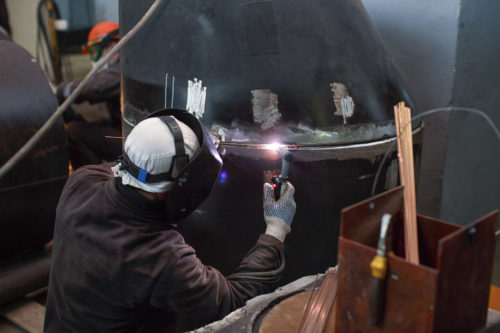 that produces the weld using a non-consumable tungsten electrode to produce the weld. The process requires shielding gas such as helium or argon to protect the welded area from contamination, and most applications will need filler metal. GTAW is a very clean welding method and requires a great deal of skill and training. It also doesn’t produce slag, making it suitable for applications requiring an attractive and neat appearance.
that produces the weld using a non-consumable tungsten electrode to produce the weld. The process requires shielding gas such as helium or argon to protect the welded area from contamination, and most applications will need filler metal. GTAW is a very clean welding method and requires a great deal of skill and training. It also doesn’t produce slag, making it suitable for applications requiring an attractive and neat appearance.
Hardwire
The most common type of wire used with MIG welding is hardwire. Hardwire works best with a mix of 75% argon and 25% carbon dioxide. There are several types of hardwire, all of which are used in welding mild steel and have varying levels of hardness. Hardwire does not produce slag, making it one of the most efficient welding processes. It can also be used to weld in any position, including horizontal, diagonal, downhill, uphill, flat, and overhead.
Trade Tech: Your Certified Welding Experts
At Trade Tech, our certified welding experts are skilled in a wide range of arc and resistance welding processes, including MIG welding, TIG welding, FCAW, GMAW, and GTAW. We maintain certifications in AWS D1.1, AWS D1.6, and AWS D14.1, and we invest in the latest welding equipment to ensure precision welds for industries such as mining, nuclear power, and industrial equipment. To learn more about our certified welding capabilities, contact us today or request a quote for your next project.
An Intro to the CNC Machining Process
An Intro to the CNC Machining Process
Computer numerical control (CNC) machining is a subtractive manufacturing process that uses computer-guided machinery and tooling. It is similar to manual machining processes in that it employs various tools to remove excess material from the workpiece (i.e., the blank) to achieve the desired shape and size. The main difference is that the motion and action of the tools and/or the workpiece are controlled by a computer program rather than a human operator. Key advantages include better accuracy, precision, and speed, all of which benefit the manufacturer and end user.
The term “CNC machining” is a broad term that encompasses all of the machining processes that utilize computerized machines and tools. The following blog post provides an overview of some of the most commonly utilized ones.
CNC Milling
CNC milling is a machining process that uses computerized multi-point cutting tools to shape the workpiece into the desired form and size. During CNC milling operations, the tool rotates as the CNC milling machine feeds the workpiece toward it. Generally, the feed direction is the same as the direction of the tool’s rotation. 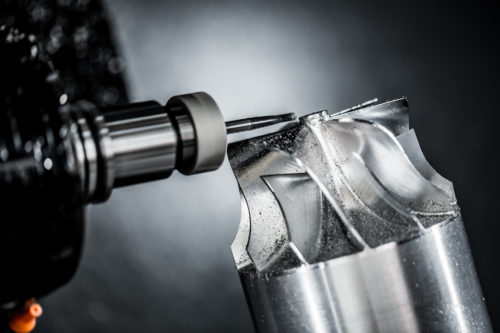
The CNC milling process can be used for a number of machining operations, such as:
- Face milling: a process that produces shallow, flat surfaces or flat-bottomed cavities
- Plain milling: a process that can produce deep cuts or wide cuts, depending on the type of cutter employed
- Peripheral milling: a process that produces deep cavities (e.g., slot, threads)
- Angular milling: a process that produces angular elements (e.g., chamfers, grooves, serrations)
- Forming milling: a process that produces components with curved and flat surfaces or completely curved surfaces
CNC Drilling
CNC drilling is a machining process that uses computerized multi-point drill bits to create smooth or threaded holes in the workpiece. During CNC drilling operations, the cutting tool generally rotates and moves perpendicular to the surface of the stationary workpiece, producing vertically aligned holes. However, specialized machine configurations and workholding devices can be utilized to create angular holes.
The CNC drilling process can be used for many machining operations, such as:
- Counterboring
- Countersinking
- Reaming
- Tapping
CNC Boring
CNC boring is a machining process that enlarges the size of existing pre-drilled, forged, or cast holes in the workpiece. During CNC boring operations, excess material inside of the target hole is carefully removed. This continues until the hole is the right size/shape, of the right surface roughness, and/or in the correct position.
The CNC boring process can be performed by various machining units, such as lathes, jig borers, or boring mills. Larger workpieces are typically machined using a boring mill, while smaller components are generally machined using a lathe.
CNC Turning
CNC turning is a machining process that uses computerized single-point cutting tools to remove material from the workpiece. During CNC turning operations, the workpiece rotates while the machine feeds the tool along its surface in a linear motion to remove excess material around its diameter. The material removal continues until 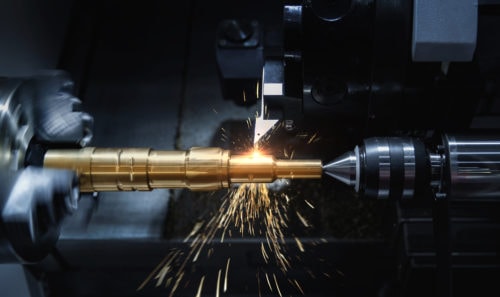 the component has the proper diameter(s). The result is generally a cylindrical component with or without external and internal features (e.g., slots, tapers, or threads).
the component has the proper diameter(s). The result is generally a cylindrical component with or without external and internal features (e.g., slots, tapers, or threads).
The CNC turning process can be used for a variety of machining operations, such as:
- Boring
- Facing
- Grooving
- Thread cutting
Thread Cutting on CNC Lathes
Thread cutting is a machining process that uses an indexable threading insert in a CNC lathe to produce threads. During thread cutting operations, the CNC lathe controls the uniformity of the thread created by maintaining a programmed feed rate. The shape and size of the thread are determined by the shape and size of the threading insert.
CNC Counterboring and Countersinking
CNC counterboring and countersinking are specialized machining processes that are performed at the top of an existing hole. During counterboring and countersinking operations, the machine tool removes material at the hole opening to create space for the fastener (e.g., screw or bolt) so that it is flush with the workpiece surface when fully inserted. A countersink is conical, while a counterbore is cylindrical and usually larger in diameter than the hole’s bore.
Trade Tech: Your CNC Machining Experts
Want additional information on the different types of CNC machining processes? Ask the experts at Trade Tech! As a premier machining service provider, we can answer any questions you may have about these manufacturing methods. Additionally, if you’re looking for a partner for your next CNC machining project, we are here to help. We offer a range of capabilities, including milling, drilling, boring, turning, thread cutting, counterboring, and countersinking. Request a quote to discuss your project specs with one of our representatives.
Intro to Expander Tools for Aircraft Shrouds
Intro to Expander Tools for Aircraft Shrouds
The term “aircraft shroud” can refer to a variety of parts within an aircraft. However, it is generally a non-structural 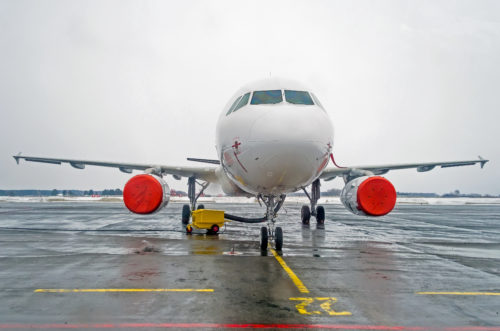 protective panel that is used to block something from view or protect it from heat, internal flow disturbance, or another potentially damaging compound or condition. Examples include an engine exhaust shroud and shroud panel, both of which are vital to keeping sensitive aircraft components safe from damage.
protective panel that is used to block something from view or protect it from heat, internal flow disturbance, or another potentially damaging compound or condition. Examples include an engine exhaust shroud and shroud panel, both of which are vital to keeping sensitive aircraft components safe from damage.
Given the important function aircraft shrouds perform, it is essential to manufacture them carefully to ensure they fully meet the necessary specifications and standards. One process commonly involved in the fabrication of a shroud is expander forming. It requires specialized tools known as expander tools.
What Are Expander Tools for Aircraft Shrouds?
Expander tools are used in forming operations to alter the size and shape of a hollow workpiece. They allow a manufacturer to increase the circumference of the workpiece as needed while maintaining a continuous cross-section.
The aerospace industry is subjected to numerous regulations regarding the design and manufacture of equipment and their components. As such, expander tools used for aircraft shrouds must be built to high levels of accuracy and precision to ensure they produce the desired parts correctly.
Machining Expander Tools for Aircraft Shrouds
At Trade Tech, we are a full-service machine shop specializing in large machining and fabrication. Throughout our over 30 years in business, we’ve provided manufacturing solutions to customers across a wide range of industries, including an expander tool for a metal forming house focusing on the aerospace industry. 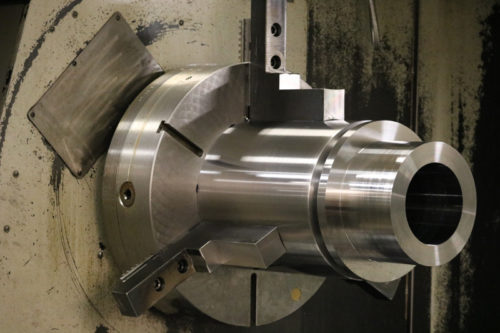
The company approached us with a request for a large-scale expander tool suitable for use on a large aircraft engine shroud. After consulting on the tool design, we manufactured all of the necessary tools for the project and completed the tool at the highest level of accuracy possible within a fast turnaround time.
The base material for the tool was A572 plate. We used state-of-the-art, high-precision machinery to manufacture the tool from the material, including a CNC vertical turret lathe, horizontal machining center, and vertical band saw. The process of making the tool involved cutting segments from forged rings, rough and finish turning the components, large vertical band saw cutting, and thick plate fabrication.
The result was an asymmetrical tool that had individual segments with unique surface profiles. It was 25 inches in diameter and 39 inches in height. We were able to produce it to tolerances of ±0.001 inches and deliver it in just six weeks.
Trade Tech — Your Full-Service Machine Shop
Making expander tools for aircraft shrouds can be tricky. However, the experts at Trade Tech are more than up to the challenge. We have the experience, expertise, and equipment needed to provide precision machining solutions for large-scale projects in some of the most demanding industries. If you need an expander tool for your aircraft shroud manufacturing operations, we’ve got you covered. We can also help with other CNC machining, large machining, and fabrication projects within the aerospace industry and beyond.
To learn more about how we serve the aerospace industry, check out our aerospace machining services page. To discuss your project specs with one of our representatives, request a quote.
A Guide to CNC Machines
A Guide to CNC Machines
Computer numeric control (CNC) machines are manufacturing units that utilize computer software to manage the motion and movement of the tools and/or workpiece during machining operations. Compared to manual machines, they can produce components with greater precision and accuracy at higher speeds since they need little to no human involvement to run once they are fully set up and programmed.
There are many types of CNC machines available, each of which can be used for different manufacturing purposes. The following guide provides an overview of the different types to help readers identify which one best suits their project. 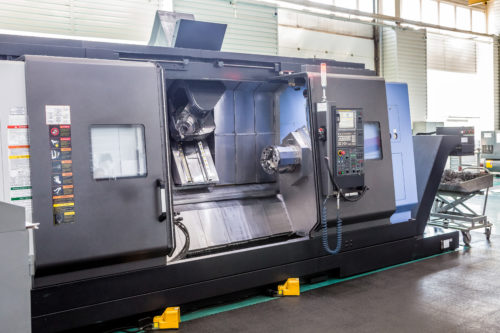
Computer numeric control (CNC) machines are manufacturing units that utilize computer software to manage the motion and movement of the tools and/or workpiece during machining operations. Compared to manual machines, they can produce components with greater precision and accuracy at higher speeds since they need little to no human involvement to run once they are fully set up and programmed.
There are many types of CNC machines available, each of which can be used for different manufacturing purposes. The following guide provides an overview of the different types to help readers identify which one best suits their project.
Horizontal & Vertical Mills
Milling machines use rotating cutting tools to remove material from stationary workpieces. They are available in two variations, based on configuration: horizontal mills and vertical mills.
Horizontal Mills
Horizontal mills have horizontally oriented machine spindles. They provide additional support and stability to the workpiece, making them better suited for larger and heavier pieces than vertical mills. Additionally, they use short and thick cutting tools, which enable them to produce heavier and deeper cuts. As a result, they are commonly utilized for the manufacture of components that require grooves or slots.
Vertical Mills
Vertical mills have vertically oriented machine spindles. They use long and thin cutting tools, which make them better suited for producing lighter and shallower cuts. As a result, they are commonly employed for die sinking applications.
There are two main types of vertical mills: turret milling machines and bed milling machines. Turret milling machines have a spindle and a table can that move perpendicular and parallel to the axis. Bed milling machines have tables that only move perpendicular to the axis. As a result of their broader freedom of motion, turret milling machines offer greater versatility than bed milling machines. They can be used for more milling operations, which is why they are often the smarter investment for manufacturers.
Boring Bars
Boring bars are tools utilized to alter the shape and/or size of existing holes in a workpiece by removing excess material from the inside. They can make the hole bigger, improve its accuracy, or enhance its surface roughness, depending on the final component specs. 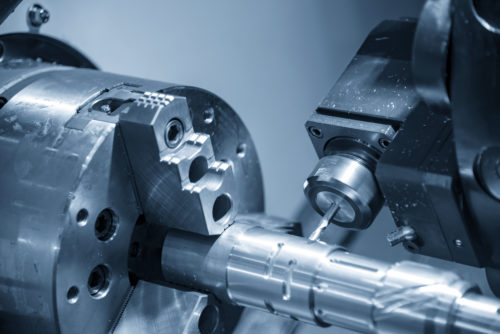
Boring operations can be performed by a variety of machines, such as drill presses, lathes, and mills. The boring bar is attached to the machine, which rotates and feeds it and/or the workpiece toward each other. Adjusting the dial screw of the bar moves the cutting bit(s) closer together or farther apart, allowing for the creation of narrower or wider cuts.
Machining Centers
Machining centers can accommodate a wide range of machine tools, which enables them to be used in many machining operations. Additionally, since they have a computerized automatic tool change function that automatically retrieves and exchanges tools for different operations, they help shorten changeover time, which saves manufacturers time and money.
These machines are primarily employed for the manufacture of dies for other manufacturing processes. However, they can also be used to create other parts and products.
CNC Lathes
Lathes are pieces of machining equipment utilized to shape a workpiece by rotating and pressing it against a single-point cutting tool. While manual lathes have been employed for hundreds of years to create various parts and products, the introduction of CNC lathes has significantly improved lathe operations. The machines allow for higher cutting accuracy and precision without sacrificing speed.
Trade Tech: Your CNC Machining Experts
The CNC machining process can be used to create a variety of components for different industries and applications. However, it is important to use the right machines and tools for the project. Otherwise, the components may not be produced successfully or cost-effectively. The machining experts at Trade Tech have the knowledge, skills, and tools needed to produce precision machined parts and products for nearly any customer project. If you want to partner with us for your CNC machining project, contact us or request a quote today.
